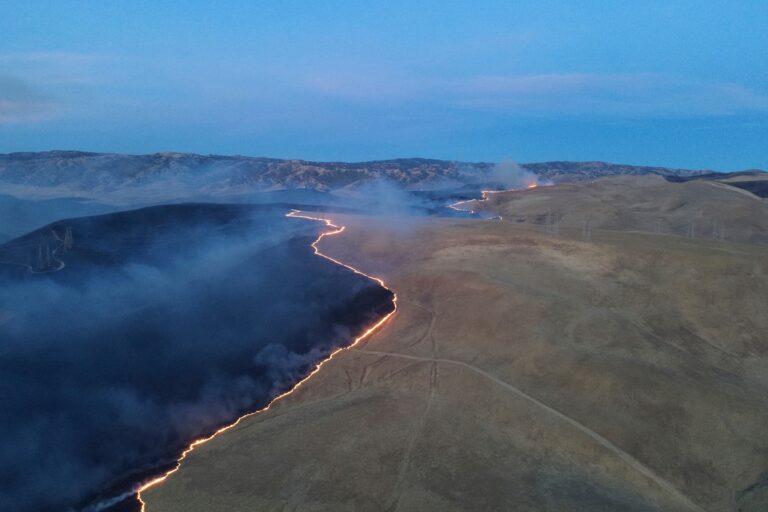Fire season started much earlier than last year due to an abundance of grass fuel. Several fires are burning across the state, and an impending heat wave in the west could further increase fire danger. But experts expect the worst of the season to come in the second half of the year, which usually runs from April to October.
The blaze, dubbed the Corral Fire, broke out over the weekend and was reported to be 90 percent contained as of Tuesday morning after burning more than 14,000 acres in San Joaquin County, just south of Tracy, California. The cause of the blaze, about 60 miles east of San Francisco, remains under investigation.
California’s fire season has become more active over the past two weeks as warm, dry weather that began in May has dried out the dense grass that grew during the past two wet winters. Once a fire starts, gusty winds can cause it to spread quickly through the dry grass.
Cal Fire reported eight fires were burning as of Tuesday morning. While many of the fires are in the central and southern parts of the state, the state’s largest blaze this year is the Corral Fire in Northern California. The blaze, fanned by gusty winds, destroyed one home, injured two firefighters, and forced thousands to evacuate, according to the Associated Press.
This year’s wildfires have burned more than 34,000 acres in the state, far exceeding the 8,500 acres that typically burn by early June and the 2,500 acres that burned during the same period last year.
For now, the fire danger is mainly limited to grasslands during windy periods. How flammable the rest of the state becomes will depend on how hot and humid this summer is. A heat wave is expected across much of the state this weekend and into the weekend, with temperatures in Central California expected to reach nearly 100 degrees Fahrenheit, which will further reduce snowpack and dry out vegetation.
There are mixed indications as to how this year’s wildfire season will unfold.
In early May, forecasters were expecting California’s abundant winter and spring rain and snow to lower fire risk through the early summer, but concerns about the second half of the season were already growing with expected summer heat and a delayed or weakening southwest monsoon.
While unexpected, the recent increase in fire activity doesn’t necessarily change future forecasts as forecasters still balance competing factors.
Meanwhile, drought, which increases fire risk, is not a major concern right now after two consecutive stormy winters. Recent warm weather has reduced the state’s snowpack by 44 percent below normal, but precipitation so far this year has been slightly above normal, so reservoir levels remain 18 percent higher than normal.
“We’re not expecting a drought for at least the next few months,” said Brent Wachter, a fire meteorologist with the National Weather Service.
Meanwhile, as the Corral Fire and other fires have already shown, abundant vegetation creates more fuel for fires, especially when combined with dry, hot weather. The Bureau of Meteorology’s forecast for June, July and August predicts above-normal temperatures across the state.
“With two straight years of wet weather and plenty of fuel, we could have an active August, especially with a warmer-than-normal July expected,” said Alex Tardy, a meteorologist with the National Weather Service in San Diego. “We’re expecting weaker monsoon activity in the West, which, combined with the recurring heat waves, could make for a fairly active August through October.”
Still, the ongoing fires leave forecasters open to new surprises and there is a lot of uncertainty surrounding the forecast.
“One way to think about early-season grass fires is that each acre that burns is one less acre of land that can burn later in the fire season when it’s dry and firefighters can’t get there right away,” says Daniel Swain, a climate scientist at the University of California, Los Angeles. I said it with X.
Diana Leonard contributed to this report.

